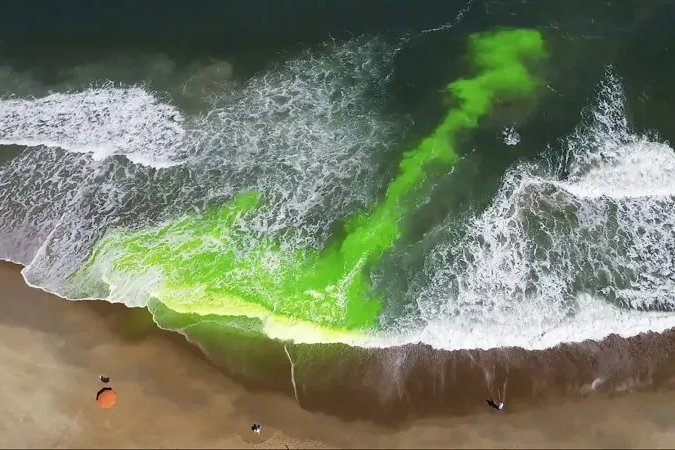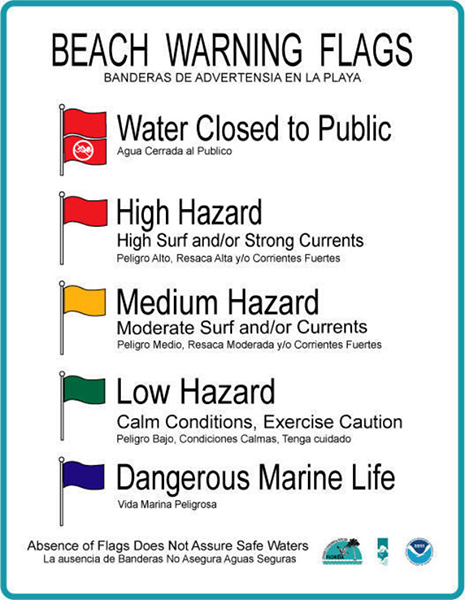While there are other dangers of swimming in the Gulf of Mexico or any coastal body of water, rip currents account for the most beach rescues in the United States. Each year approximately 100 people fatally drown along U.S. beaches from rip currents. And more than 80 percent of beach rescues annually involve rip currents. It’s important to be educated of the danger and how to prevent disaster.
As seen in the photo provided by NOAA, dye was placed in the water to show just how a rip current operates.
What are Rip Currents?
Rip currents are narrow, channeled water currents flowing quickly away from the beach and shoreline, like a swift stream in the ocean. They can carry swimmers out quite a distance from the coast, but they do not necessarily drag them beneath the sea. Rip currents commonly form at low spots or breaks in sandbars and can be near structures such as piers and jetties. Though they might occasionally happen on sunny days, they are often associated with stormy weather. The fact that the surface water frequently seems calm makes them difficult to find.
Rip currents can be identified when you see a channel of churning, choppy water; a dark color change in a particular area; a line of seaweed; or a break in the incoming wave pattern. During hurricane season, from June to November, there is a greater chance for rip currents to develop.
What to do if you are caught in a rip current? Don't panic, don't fight.
If you are caught in a rip current, don't panic and don’t fight it. The most frequent advice from beach rescue teams and weather forecasters is to not panic. The United States Lifesaving Association (USLA) recommends that swimmers who find themselves in a rip current do not try to swim back to shore. Even strong swimmers are unlikely to be able to swim against the current. They are much more likely to find themselves exhausted, an even more dangerous position.
Instead of panic striking you, look for a chance to swim parallel to the shore until you are out of the rip current’s grip. It will eventually dissipate but might leave you out in deeper water. That’s why reserving your strength is important.
You should try to go with the current as it takes you out until you are free of it. Then swim parallel to the shore and back to land at an angle. When you are out of the current, swim to shore. If you can’t swim out of the rip current, float or tread water. Face the shore, wave your hands, and yell for help if it is impossible to reach the shore. Remember to stay calm.
Should You Attempt a Rip Current Rescue?
It can be dangerous to try to rescue someone caught in a rip current, officials say. Often the people trying to perform the rescue can get into trouble themselves and often are the ones who drown. It’s best to find a lifeguard, if there is one, or call 911 if a struggling swimmer is spotted. People on shore can also try to tell the person to swim parallel to shore or throw a flotation device. Another bit of advice heard often from rescue teams is to never swim alone.
Taking Safety Precautions to Avoid Rip Currents
You should always be alert and use preventive measures to avoid rip currents at the beach. It is important to know how to swim in the surf or, if you are not a strong swimmer, have a flotation device with you. Swim near a lifeguard, use a life jacket, and have a swimming buddy to ensure your safety. Always check flags for beach conditions. If you are not sure, do not go into the water, and never go in the water on a Double Red flag.
If someone is caught in a rip current alert a lifeguard, call 911, or throw the victim a flotation device. Lifeguards are on duty at multiple locations throughout Bay, Walton and Okaloosa county. In Panama City Beach, you can find lifeguards on duty at three locations M.B. Miller County Pier (May 27 - Labor Day Weekend), Rick Seltzer Park (May 27 - Labor Day Weekend), and Russell Fields City Pier (April 1 - Labor Day Weekend). Regional Public Beach Access points in Walton county have lifeguards from March 1 through September 30. Lifeguards patrol the seven miles of beaches in Destin from March to October of each year.
What is the Beach Flag Warning System?
Bay, Walton and Okaloosa counties have flag systems in place along the beaches to inform you of the current beach conditions. Beaches on the Emerald Coast utilize this internationally accepted beach flag warning system to protect millions of visitors and locals from dangerous rip currents every year.
Green flags indicate there is a low hazard with calm conditions but stay advised. Yellow flags indicate a medium hazard with moderate surf and potentially strong currents. Red flags indicate a high hazard of rip currents and high surf and strong currents. Double Red flags indicate that the water is closed to the public and indicate a very high hazard of rip currents and dangerous surf. Purple flags indicate marine life present in the water. Marine life could be any number of things including jellyfish, predators, or red tide bacteria.
Double-red flags are no joke and should be taken extremely seriously. They indicate the Gulf is closed to swimmers. If you are found swimming in the water during double-red flags, a $500 fine is implemented, and a second offense is $1,000. Obeying Double Red Flag warnings is for your own safety and for the safety of others who may jump in the surf to try and save you from drowning. No one is safe when rip currents are strong in the water.
It’s important to note that surfers are the only people allowed in the water during Double Red Flag conditions. That is because their surfboards are attached flotation devices providing additional safety measures.
If you'd like text alerts when the flags change, you can sign up by texting "PCBFLAGS" to 888777. For beaches on 30A, text "SAFETY" to 31279. In Destin, text "BEACH" to 44144.
Adhere to Safely Systems, Avoid Rip Currents, and Have a Safe and Fun Vacation
We want you to enjoy your vacation and have a safe trip to the beaches. When swimming and enjoying the gulf waters, safety should be a top priority for you and everyone in your party. Rip currents are no joke, and safety systems are put in place by those with decades of experience across the country. By paying attention to the beach flags and using proper precautions, you can have a happy and safe vacation.
Browse the best selection of vacation rentals from Panama City Beach to 30A to Destin and book your stay with us!


